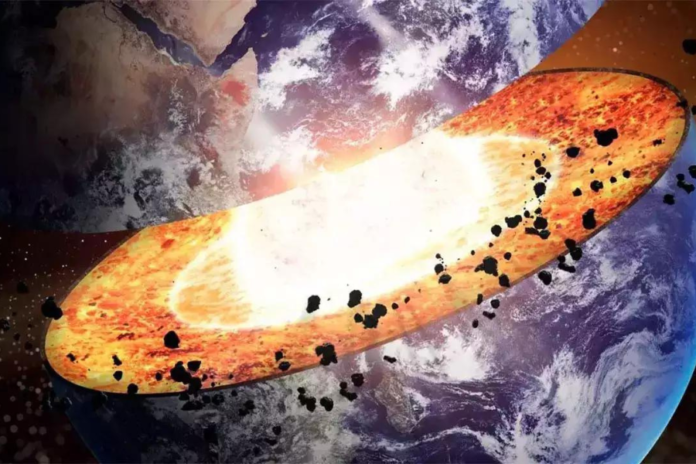Since the 1970s, seismologists have been able to identify two unexplained continent-sized blobs, one under Africa and the other under the South Pacific, that are located in the lowest portion of Earth’s mantle.
Researchers said that these blobs, which are denser than the material around them, might be remnants of the early planetary cataclysm that is thought to have given rise to the moon. This cataclysm is thought to have resulted from the collision of primordial Earth with a Mars-sized object known as Theia.
Melted rock was launched into space by this massive impact, which occurred more than 4.46 billion years ago, according to recent research. The rock circled Earth and eventually solidified into the moon. However, it’s possible that some of Theia stayed inside Earth and sank to a location slightly above the extremely hot spherical iron and nickel core of our planet.
The impact event, the evolution of Earth’s mantle, the thickest layer that makes up the interior structure of our planet at 1,800 miles (2,900 km), and the geophysical characteristics of the material that most likely comprised Theia were all examined by the researchers using computer simulations.
Scientists have postulated, based on these simulations, that the moon was formed by leftover debris from Theia’s absorption into Earth, which resulted in the blobs.
“The bottoms of these blobs are 2,900 kilometers below our feet. The two blobs are about 2% of Earth’s mass. They were detected by seismology as seismic waves travel slower within these two regions compared to the surrounding mantle. Each of the blobs are twice the mass of the whole moon. So, the blobs are massive,” said Caltech geophysicist Qian Yuan, lead author of the study published in the journal Nature.
These blobs would be elusive proof of the proposed moon-forming collision right here on Earth if the study’s conclusions hold true.
Paul Asimow, a professor of geology and geochemistry at Caltech and a study co-author, said there hasn’t been much agreement on whether we can find evidence for this event not only in the moon but also in some observable property of the modern Earth.
According to Asimow, the two blobs “are the biggest deviations in Earth’s structure from a simple layered planet.”
“It is amazing because, if we delve far enough into Earth’s mantle, we can find remnants of another planet—Theia,” said Hongping Deng, a planetary scientist and study co-author from the Shanghai Astronomical Observatory of the Chinese Academy of Sciences.
Similar to moon rocks, the blobs’ high iron content is assumed to be the cause of their increased density, which makes sense if they are composed of the same material.
“After the impact, these impactor materials would sink down to the core-mantle boundary because they likely have higher density than ambient mantle, and it is the extra density that allows them to survive Earth’s whole history,” Yuan stated.
With an average orbital distance of roughly 239,000 miles (385,000 km), the moon is slightly larger than a quarter of our planet’s diameter, measuring about 2,160 miles (3,475 km).
According to Asimow, if their findings hold true, some volcanic rocks that reach the surface of the Earth might contain remnants of a planet that has dissolved.
“If our model is correct, the blobs should have isotopes – trace elements – that are similar to the lunar mantle rocks, which can be tested in future lunar missions,” Yuan stated.
Understanding the giant impact more thoroughly could shed light on how Earth and other rocky planets in our solar system and beyond have evolved.
“Earth is still the only confirmed habitable planet, and we do not know why,” Yuan stated. “The conditions for Earth’s evolution were probably established by this collision. Analysing its effects could aid in our quest to understand what makes Earth unique among rocky planets.”



